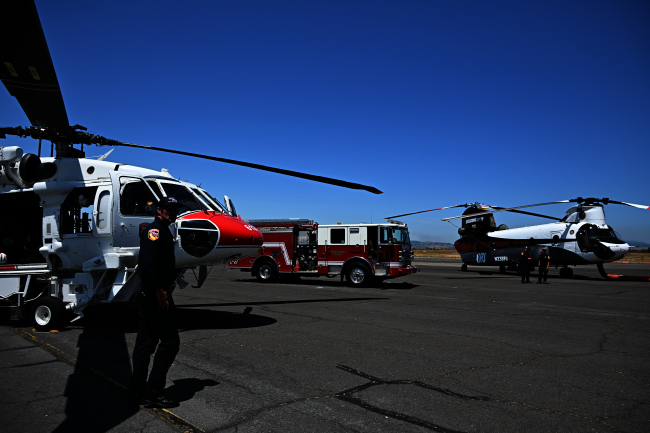
NAPA COUNTY, Calif. — As cool winds blew and aircrafts taxied nearby, Cal Fire’s Sonoma-Lake-Napa Unit showcased its aerial firefighting muscles — helicopters and crews — at the Napa County Airport on Monday.
Each of the three helicopters on display is based in a different county within the unit: a Cal Fire Hawk — a Sikorsky S-70i in signature red-and-white — with its helitack crew stationed at the Boggs Mountain Helitack Base in Lake County.
Also featured were a Boeing CH-47D Chinook based at the Napa County Airport and a Sikorsky UH-60A+ Blackhawk based at the Charles M. Schulz Sonoma County Airport.
The later two are contracted with Cal Fire for exclusive aerial firefighting operations this summer into the fall.
“These aircraft displayed behind me today represent a strategic investment in wildfire preparedness and rapid response," said Unit Chief Matt Ryan in his speech. “Cal Fire has deployed aircraft across California ahead of peak fire conditions to ensure a rapid, aggressive initial attack.”
Ryan highlighted the helicopters’ capability.
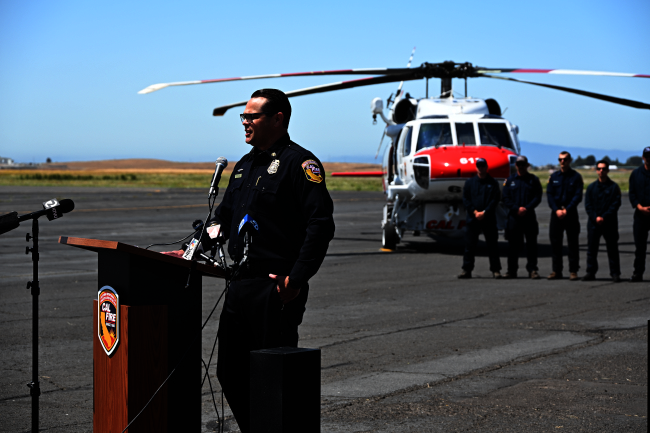
The Fire Hawk is “a state-of-the-art firefighting helicopter as an initial attack with wildfire suppression and rescue operations, Ryan said. It delivers a helitack crew directly to the fire line with 1m000 gallons of water.
The Chinook can carry up to 26,000 pounds, delivers up to 2,300 gallons of water and is qualified for night operations; The Blackhawk has a capacity of 1100 gallons of water designed for rapid deployment.
“These aviation resources are key to achieving one of Cal Fire's core objectives — containing 95% of wildfires at 10 acres or less,” Ryan said. “Together, our air and ground resources enhance our ability to protect the lives, property and natural resources of California.”
As Ryan spoke, firefighters in dark blue uniforms stood against the backdrop of their towering mechanical counterparts.
Since 2021, Napa County “has seen just eight wildfires that exceeded 10 acres in size, an average of just two per year,” said the county’s Board of Supervisors Chair Anne Cottrell during her speech. Over the 10 years prior to 2021, Cottrell said, Napa had 46 wildfires over 10 acres — nearly five a year.
The reduction in wildfire was “remarkable” and “a testament to Cal Fire’s rapid response strategy,” she said.
The unit’s Public Information Officer Jason Clay told Lake County News that aircraft or helicopters are “strategically positioned throughout California” to be able to respond to any fire across the state within 20 minutes.
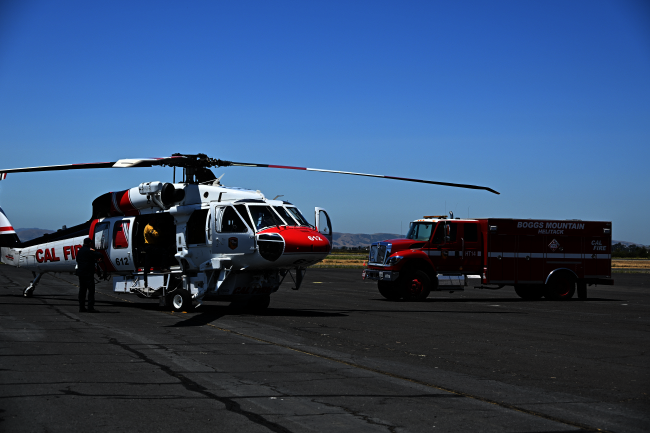
The Fire Hawk and helitack team based in Lake County
It took the Fire Hawk 15 minutes to fly the helitack team from their base in Boggs Mountain, Lake County to the event in Napa, according to the crew. By car, the trip would have taken two hours.
For some firefighters there, the commute to work is even longer.
Jake Gallant, a firefighter who lives in San Luis Obispo, said he has a four-hour drive to Lake County. “I have the farthest commute,” he said with a laugh.
Gallant explained that their shifts are “three days on, four days off” so that he does not have to make the drive every day.
“I mean, it’s actually pretty common in Cal Fire for people to live further away from where they work,” he said. “I wouldn't get this opportunity to work on a Cal Fire Hawk closer to where I live. So it’s worth it to me.”
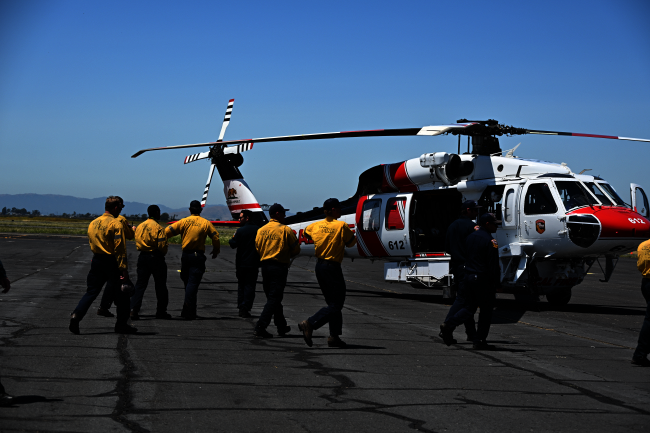
Gallant has spent three of his seven years in firefighting on the helicopter crew. “I love it. It’s the best job I ever had,” he said.
Before firefighting, Gallant said he had done many jobs in construction, moving — mostly manual labor.
“Well, they do a lot of manual labor,” Gallant said of transitioning to firefighting. “And I’m pretty good at that, so might as well do something cool with it.”
This year, the heliteck crew has attended and landed for 13 fires so far, according to Fire Captain Chris Batey who has been in firefighting since 2001 and came to the base four years ago.
Speaking of the fire trends throughout the year, “We get highs and lows,” Batey said. “Last year we started off much busier than this year — we went straight into a couple fires that burned down 10,000 acres each.”
“This year, it’s been really slow — small fires, not doing a whole lot — which is the way we like it; it’s way better,” Batey said.
In 2024, the Boggs Mountain helitack team landed and took action on 54 fires, Batey and Gallant recalled. “There's probably 100 more that we started to but they didn't need us, or we were canceled,” Gallant added.
Batey told Lake County News that it costs about $7,000 an hour for the Fire Hawk and crew to work on an ongoing fire, covered by the unit’s operating budget.
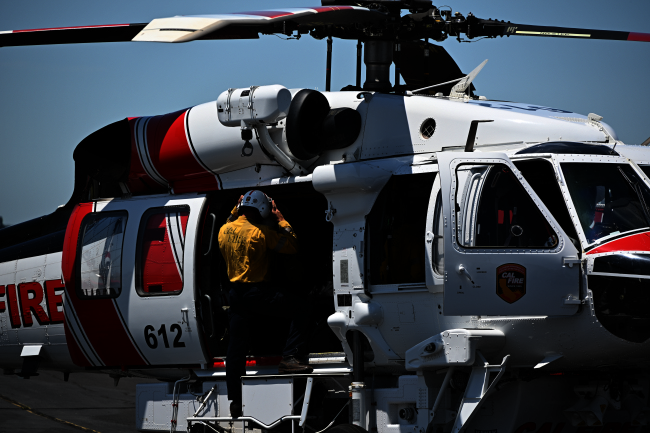
This Fire Hawk-Sikorsky S-70i is the only helicopter at the helitack base right now, according to Gallant. The aircraft and the crew, while showing up in the event, were actively on call.
“So if there is a fire, we will leave,” Batey said.
For the pilot, Michael Schanley, firefighting from the sky has “a tremendous amount of variables — whether it’s the wind, the heat.”
Schanley has been with Cal Fire for six years of his total of 38 years primarily for aerial firefighting, having previously worked as a contractor.
He likened the job to a boxing match. “I have an opponent in a fire, and the fire doesn't just wait for me to go make another drop,” Schanley said in explaining his theory.
“The fire is doing its thing and we're chasing it right?” he said. “We chased it down. And then at some point, we kind of reached an equilibrium, and then we started getting the upper hand — getting a little head of the fire, and we're doing our part. And then eventually it goes out …”
“Mike, I think we got a job at Contra Costa,” a crew member interrupted.
The conversation ended. Quickly, dark blue uniforms were swapped for bright yellow as the Fire Hawk’s engine started humming, rotors spinning, kicking up dust on the ramp before taking off.
Four minutes later, they arrived at the fire scene.
Email staff reporter Lingzi Chen at
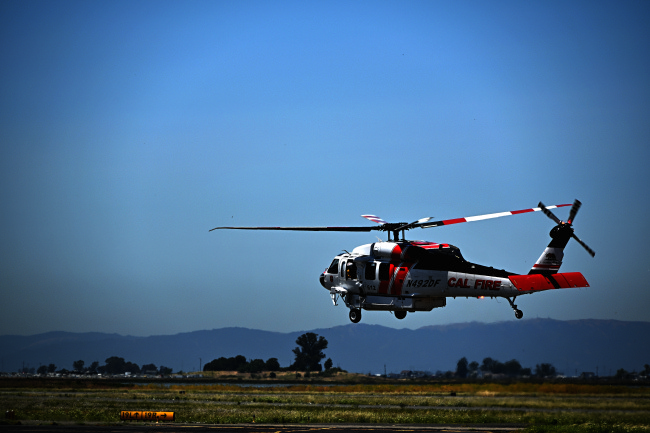

 How to resolve AdBlock issue?
How to resolve AdBlock issue? 



